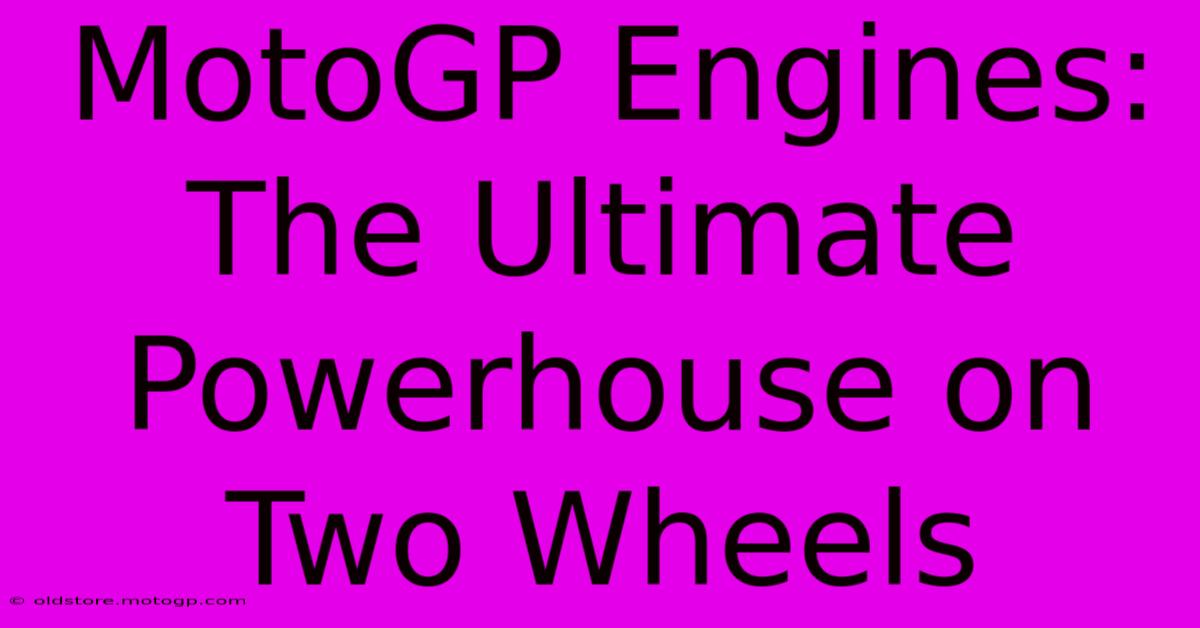MotoGP Engines: The Ultimate Powerhouse On Two Wheels

Table of Contents
MotoGP Engines: The Ultimate Powerhouse on Two Wheels
MotoGP, the pinnacle of motorcycle racing, showcases the most advanced and powerful machines on two wheels. At the heart of these incredible racing bikes lie their engines – sophisticated powerhouses meticulously engineered for ultimate performance. This article delves into the intricacies of MotoGP engines, exploring their design, technology, and the relentless pursuit of speed and efficiency.
The Heart of the Beast: Engine Specifications
MotoGP engines are purpose-built, representing the pinnacle of internal combustion engine design. Currently, the class utilizes protoype 1000cc four-stroke engines, a significant departure from the two-stroke screamers of the past. These engines aren't just powerful; they're incredibly sophisticated pieces of engineering. Key characteristics include:
- Four-cylinder configuration: This layout offers a good balance of power, torque, and manageability. While other configurations exist, the inline-four reigns supreme in MotoGP.
- High RPM capabilities: These engines routinely rev to incredibly high RPMs, often exceeding 16,000 RPM, extracting maximum power from every drop of fuel.
- Sophisticated electronics: Modern MotoGP bikes rely heavily on sophisticated electronics, including engine management systems, traction control, wheelie control, and launch control. These systems fine-tune engine performance and rider safety in real-time.
- Lightweight materials: The quest for speed and agility necessitates the use of lightweight materials like titanium, magnesium, and carbon fiber in the engine's construction.
- Pneumatic valve actuation: Some manufacturers utilize pneumatic valve actuation systems, which offer faster valve opening and closing times, allowing for even higher engine speeds.
Fuel Restrictions and Efficiency
Despite their immense power, MotoGP engines are subject to strict fuel regulations. This encourages teams to focus on fuel efficiency alongside power output. Clever engine designs and advanced fuel injection systems play a crucial role in optimizing fuel consumption while maintaining competitive lap times. The challenge lies in striking the perfect balance between raw power and fuel efficiency – a testament to the engineering prowess displayed in MotoGP.
The Technology Behind the Power
The technology employed in MotoGP engines is constantly evolving. Manufacturers are in a relentless arms race, striving for marginal gains in performance. Some of the key technological advancements include:
- Seamless shift transmission: Allows for incredibly quick gear changes without the need to close the throttle, crucial for maintaining momentum around corners.
- Ride-by-wire throttle: Provides precise throttle control and allows for sophisticated electronic intervention to prevent wheelspin and wheelies.
- Variable valve timing: Optimizes engine performance across a broader range of RPMs, resulting in improved power delivery.
- Advanced materials and manufacturing techniques: Constant refinement in materials science and manufacturing processes constantly push the boundaries of what's possible.
The Future of MotoGP Engines
The future of MotoGP engines is likely to see further refinements in existing technologies and the exploration of new possibilities. Hybrid technology might eventually make an appearance, although regulations currently focus on pure internal combustion engines. The ongoing push for sustainability could lead to the exploration of alternative fuels or more efficient engine designs. Regardless, the relentless pursuit of speed and efficiency will continue to drive innovation in MotoGP engine technology.
Conclusion:
MotoGP engines represent the epitome of motorcycle engine technology. Their power, sophistication, and cutting-edge engineering make them true powerhouses on two wheels. The constant evolution of these engines pushes the boundaries of what's possible and delivers some of the most exciting and competitive racing in the world. The relentless quest for speed and performance ensures that MotoGP will continue to be at the forefront of motorsports innovation for years to come.

Thank you for visiting our website wich cover about MotoGP Engines: The Ultimate Powerhouse On Two Wheels. We hope the information provided has been useful to you. Feel free to contact us if you have any questions or need further assistance. See you next time and dont miss to bookmark.
Featured Posts
-
Motorcycle Race Bikes For Sale Your Championship Awaits
Feb 20, 2025
-
Yamaha Moto Gp Racing Manufacturer Team News Whats Next
Feb 20, 2025
-
Sprint Races Reigniting The Passion For Moto Gp
Feb 20, 2025
-
Moto2 Standings A Must Read For Motorsport Fans
Feb 20, 2025
-
Unlock The Best Austin Grand Prix Experience Parking Made Easy
Feb 20, 2025
